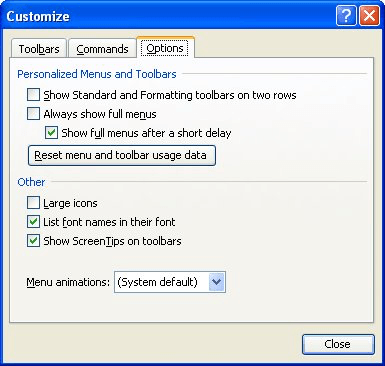When you click the Font drop-down list on the Formatting toolbar, Excel shows you the names of all the fonts you can use to format whatever you have selected on the screen. Normally, Excel shows the font names using the actual font. You may find the differing font faces to be distracting, or your slower computer may be really slow when listing all the fonts.
Here's how you turn this capability on and off in Excel 2000, Excel 2002, and Excel 2003:

Figure 1. The Options tab of the Customize dialog box.
ExcelTips is your source for cost-effective Microsoft Excel training. This tip (2832) applies to Microsoft Excel 2000, 2002, and 2003.

Program Successfully in Excel! This guide will provide you with all the information you need to automate any task in Excel and save time and effort. Learn how to extend Excel's functionality with VBA to create solutions not possible with the standard features. Includes latest information for Excel 2024 and Microsoft 365. Check out Mastering Excel VBA Programming today!
Do you wish that the buttons on your Excel toolbars were easier to see and use? The answer could be to turn on the large ...
Discover MoreCreate your own toolbars and, at some point, you may have a hankering to change their names. Here's how you can make the ...
Discover MoreOnce you've edited your toolbars, you may want to change them back to their default appearance and behavior. This tip ...
Discover MoreFREE SERVICE: Get tips like this every week in ExcelTips, a free productivity newsletter. Enter your address and click "Subscribe."
There are currently no comments for this tip. (Be the first to leave your comment—just use the simple form above!)
Got a version of Excel that uses the menu interface (Excel 97, Excel 2000, Excel 2002, or Excel 2003)? This site is for you! If you use a later version of Excel, visit our ExcelTips site focusing on the ribbon interface.
FREE SERVICE: Get tips like this every week in ExcelTips, a free productivity newsletter. Enter your address and click "Subscribe."
Copyright © 2026 Sharon Parq Associates, Inc.
Comments